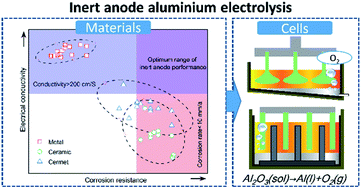Recent progress of inert anodes for carbon-free aluminium electrolysis: a review and outlook
Abstract
Carbon-free aluminium electrolysis based on inert anodes is a disruptive and fundamental technology to reach the goal of carbon neutrality in the electrolytic aluminium industry, since it only releases O2 instead of CO2 derived from conventional aluminium electrolysis using carbon anodes. In recent years, the optimization of material preparation and advances in electrolysis progress have provided new opportunities for the industrial application of inert anodes. The research on inert anode materials has attracted considerable attention due to the big challenge of performance requirements under harsh working environment during electrolysis. Metals and cermets are the most likely alternative materials to carbon anodes, with satisfactory electrical conductivity, high thermal shock resistance and appropriate corrosion resistance. This review therefore introduces the development of inert anode materials and highlights their latest research progress in material design and electrolysis performance. The properties of different kinds of materials, particularly electrical conductivity and corrosion resistance, are compared systematically to provide a basis and reference for the selection and application of inert anode materials in the future. Finally, according to the latest advances in the industrial application of inert anodes, the development trends concerning electrolysis cells and process are discussed, with the aim of providing promising research directions for the inert anode technology.

- This article is part of the themed collection: Journal of Materials Chemistry A Recent Review Articles


 Please wait while we load your content...
Please wait while we load your content...